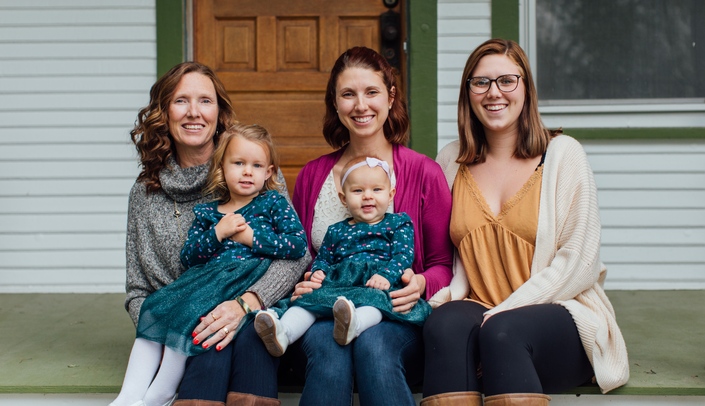One of seven daughters, Gwen Blum has two daughters of her own and two young granddaughters.
She also has the BRCA1 mutation, increasing her risk of breast and ovarian cancers.
More than a year ago, Blum’s father tested positive for the BRCA1 gene, sending Gwen and her family on a journey of discovery that included genetic counseling, testing and life-changing decisions.
“When we started talking about BRCA I didn’t think it would amount to much, but I couldn’t have been more wrong,” said Gwen’s husband, Rick Blum, chief administrator in the UNMC Department of Obstetrics and Gynecology and the Olson Center for Women’s Health.
When to seek genetic testing
Dr. Griffin has her own backstory with the BRCA gene. Her late aunt, Judy, tested positive for the BRCA2 mutation in the early 2000s, after knowing of cousins with ovarian cancer and having undergone chemotherapy herself, for breast cancer during her 40s. Three of Aunt Judy’s four siblings, including Dr. Griffin’s father, tested positive for the mutation. Fortunately, Dr. Griffin and her sister tested negative.
Dr. Griffin advises genetic testing for anyone with:
- A strong history of breast, ovarian or other cancers that run in the family;
- First, second and third-degree relatives with breast and/or ovarian cancer, especially if diagnosed at a young age (less than 45 years);
- Relatives with known positive genetic tests; and/or a
- Personal history of cancer diagnosis.
She urged families to seek the advice of a genetic counselor who can help discern whether genetic testing is needed, and, if so, who should be tested and what tests should be done.
Terri Blase, a genetic counselor at UNMC’s Munroe-Meyer Institute who specializes in hereditary cancer, agrees. “If you have any concerns or worry, come see us and we can assess your family’s history.”
Gwen and her daughter, Hannah, shared their personal stories at the recent Olson Center Brown Bag luncheon — as well as in the Omaha World-Herald – to raise awareness and reduce the stigma of cancer-preventing surgery.
The story of Angelina Jolie’s preventive double mastectomy in 2013 raised awareness of BRCA and genetic testing. Advances in medical genetics testing have made Jolie’s scenario more common – including for the Blum family. “I hadn’t even considered it something that would truly impact me,” Hannah said. “It seemed far away, but there’s a pretty strong (cancer) history for us.”
Although the family’s history of breast and ovarian cancer went back several generations (Gwen’s grandmother and great aunt), the family had to convince Gwen’s nearly 80-year-old father to undergo genetics testing. Of his seven daughters, only Gwen’s test came back positive (one sibling has not been tested). “My mom was the fourth to get the results,” Hannah said, “so it was ‘negative, negative, negative, and then ‘Merry Christmas, I’m positive.’ ”
Once Gwen knew her results, the Blum children — Hannah, Lucas and Haley — also were tested. The girls tested positive; their son tested negative and does not have the mutation.
A positive test, the Blums said, means they have inherited a mutation in the breast cancer gene and have an increased risk of developing breast cancer. The lifetime risk for those with BRCA1 mutation genes increases from 12 percent to 87 percent for breast cancer, and 6 percent to 44 percent for ovarian cancer.
“More glaring to me (than the 87 percent lifetime risk) was the 13 percent chance of not getting breast cancer,” Gwen said. “That was the number I focused on.”
Because Gwen was 52 and past childbearing age, she elected to remove her ovaries and fallopian tubes, as experts advise. “Ovarian cancer is a silent killer,” she said, noting the lack of screening tools.
Unlike ovarian cancer, screening tools exist for breast cancer including mammograms and MRIs, said Jennifer Griffin, M.D., an associate professor for the department of obstetrics and gynecology.
After careful input from physicians and counselors, Gwen said she opted for a prophylactic double mastectomy with reconstruction, noting how preventive tools screen, but don’t prevent cancer.
Hannah has chosen a different route – for now. Thirty and pregnant when she tested positive for the BRCA1 mutation, Hannah continues to breastfeed 7-month-old Edith and hopes to have more children. She will undergo regular screenings every six months – as is recommended – until the time is right for preventive surgery, which she knows will trigger early menopause.
“I see my fate in front of me,” Hannah said, “but we have this information and we can do something about it.”
And, she’ll recommend that her own daughters be tested when they are adults. Experts recommend undergoing genetics testing at age 25, which is the time individuals at risk also should begin regular, preventive screenings.

Amazing story, courageous and inspiring family!
Thanks for sharing your story, Blum Family! You are beautiful and strong.
I am a daughter and great-granddaughter of women who died of ovarian cancer. Your story pushed me to finally get tested. Thank you for sharing.
A high five to the Blum family. Your sharing this story will no doubt help others!